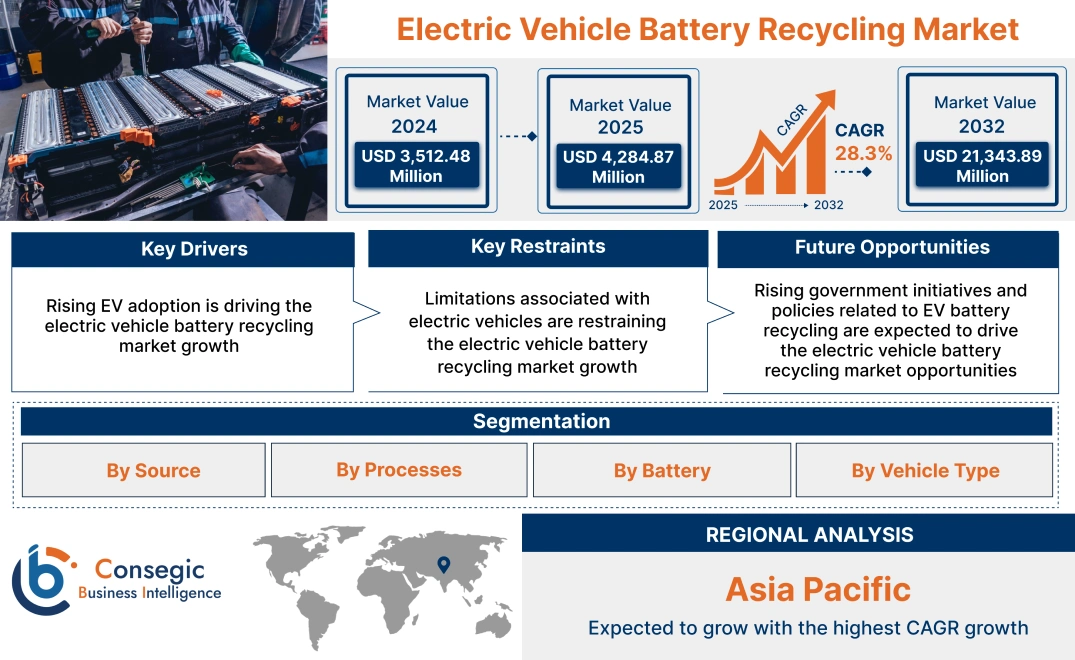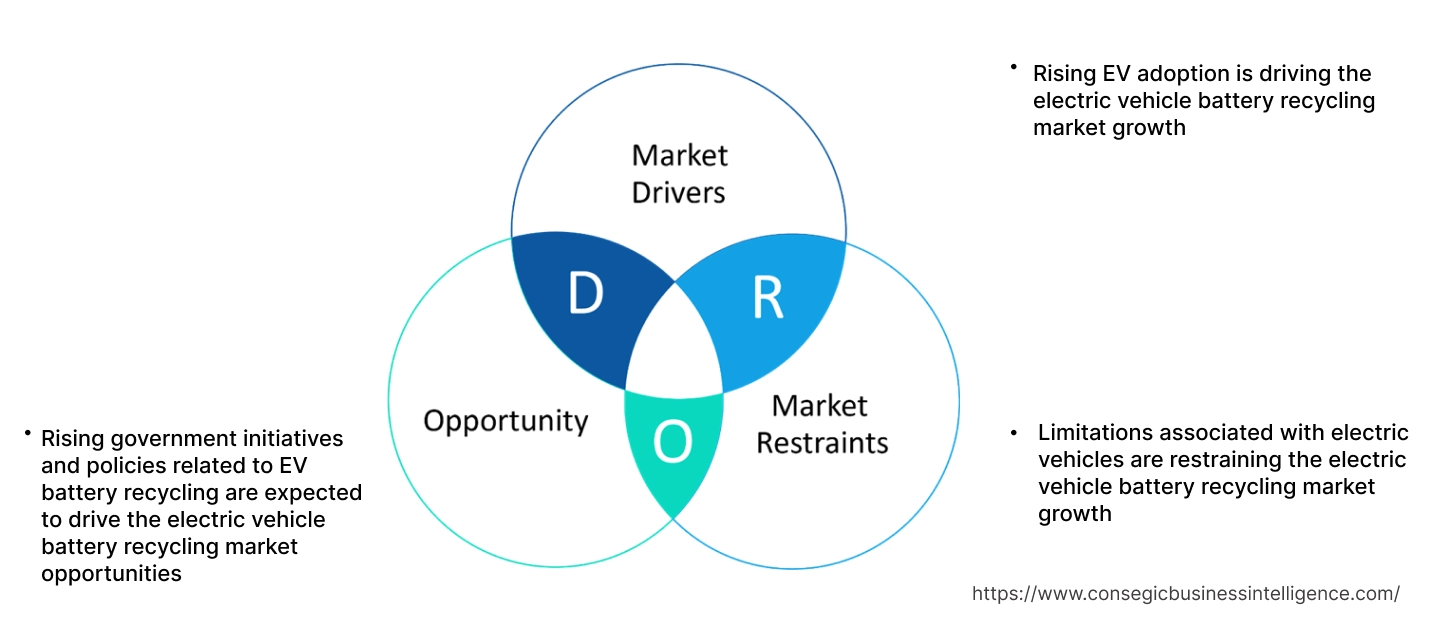- Summary
- Table Of Content
- Methodology
Electric Vehicle Battery Recycling Market Size:
Electric Vehicle Battery Recycling Market size is estimated to reach over USD 21,343.89 Million by 2032 from a value of USD 3,512.48 Million in 2024 and is projected to grow by USD 4,284.87 Million in 2025, growing at a CAGR of 28.3% from 2025 to 2032.
Electric Vehicle Battery Recycling Market Scope & Overview:
Electric vehicle battery recycling refers to a process of extracting and reusing valuable materials such as cobalt, lithium, aluminum, and nickel for producing new products and batteries. This process includes battery collection from various sources including dealerships, battery service centers, and car manufacturers. Further, collected batteries are inspected and classified to determine battery condition before refurbishing the battery. Moreover, inspected battery is sent to recycle and disassembling facility for extracting and recycling the battery through various techniques including pyrometallurgical processes, hydrometallurgical processes, and mechanical separation.
Key Drivers:
Rising EV adoption is driving the electric vehicle battery recycling market growth
There is a rising trend towards adoption of electric vehicles over combustion engines due to its various advantages including energy saving, low energy costs, reduced carbon emissions, eco-friendliness, and others. Further, electric vehicle draws energy from the batteries for its operation and does not emit carbon footprints, which makes it ideal for supporting stringent government & environmental regulations and sustainability across regions. This is further increasing advancements in efficient battery management solutions including the recycling of EV batteries.
- For instance, according to the International Energy Agency (IEA), the total sales of electric car reached nearly 14 million in 2023, representing a year-over-year increase of 35%.
Thus, the rising adoption of electric vehicles is driving the electric vehicle battery recycling market size.
Key Restraints:
Limitations associated with electric vehicles are restraining the electric vehicle battery recycling market growth
The primary limitations associated with electric vehicles include limited battery range, short battery lifespan, limited electric vehicle charging infrastructure, slow charging speeds, high cost, low top speeds, and others. Further, charging electric vehicles relatively consumes a longer time as compared to filling tanks of combustion engine vehicles.
Moreover, rising concerns associated with lifespan of electric vehicle batteries hinder the widespread adoption of electric vehicle, as the cost of replacing batteries outside warranty periods can be substantial. The above factors are further hampering the adoption of electric vehicles, in turn constraining the electric vehicle battery recycling market expansion.
Future Opportunities :
Rising government initiatives and policies related to EV battery recycling are expected to drive the electric vehicle battery recycling market opportunities
Several governments across the world are launching initiatives to recycle electric vehicle batteries due to its various benefits including substantial drop in greenhouse gas emissions, significant reductions in energy and transportation cost for producing electric vehicles, and others. Further, the rising demand and unavailability of metals such as lithium, lead, sodium, and others are catered through recycling old electric vehicle batteries. Additionally, consumer preference towards sustainability and carbon footprint reduction are driving the adoption of recycled electric vehicle battery.
- For instance, in April 2024, European Union collaborated with India for promoting start-up collaboration on electric vehicles battery recycling under the India-EU Trade and Technology Council.
Thus, as per the electric vehicle battery recycling market analysis, rising government initiatives associated with EV battery recycling are driving the global electric vehicle battery recycling market opportunities.
Electric Vehicle Battery Recycling Market Segmental Analysis :
By Source:
Based on source, the market is segmented into car manufacturers, dealerships, and battery service centers.
Trends in the Source:
- There is an increasing trend towards adoption of battery service centers for recycling of EV batteries.
- Rising adoption of EV battery recycling by car manufactures due to various benefits including end to end management of battery.
Dealerships accounted for the largest revenue in the total electric vehicle battery recycling market share in 2024 and it is anticipated to register the fastest CAGR during the forecast period.
- An EV dealership refers to a business which sells used and new cars through retail channel, based on dealership contract with an EV manufacturer.
- Further, EV dealer provides various benefits including financing options, legal protections, after sale convenience, genuine spare parts, vehicle
warranty, and others. - Moreover, EV batteries are collected from automobile dealers for efficient recycling and maintaining centralized collection.
- For instance, BMW offers electric vehicles in its product offerings. The company’s electric vehicles are sold by various dealers including Al Futtaim Motors, RMA Motors Dubai, ALBA cars, The Elite Cars, and others. These car dealers further collects the EV batteries for supplying it to recycling facilities.
- Thus, the rising sales of EVs from vehicle dealership channels are driving the electric vehicle battery recycling market size.
By Processes:
Based on the processes, the market is segmented into hydrometallurgical processes, pyrometallurgical processes, mechanical processes, and others
Trends in the Processes:
- There is an increasing trend towards adoption of hydrometallurgical process for improved efficiency in recycling of batteries.
- Increasing utilization of pyrometallurgical process due to various benefits including elimination of sorting and reduction of volume.
Hydrometallurgical processes segment accounted for the largest revenue in the total electric vehicle battery recycling market share in 2024.
- The hydrometallurgical process is widely used for recycling of EV batteries including lithium-ion batteries due to its enhanced efficiency in recovering crucial metals.
- Further, hydrometallurgical process is divided into three major steps including leaching, purification and separation, and recovery of the metal salts.
- Moreover, hydrometallurgical approach reduces the need for energy intensive methods and offers substantial benefits in terms of sustainability and purity.
- For instance, GEM Co., Ltd. offers recycling of electric vehicle battery in its product offering through hydrometallurgical process. Its hydrometallurgical process is effective in removing critical materials.
- Thus, the rising utilization of hydrometallurgical process for recycling batteries of electric vehicles are driving the electric vehicle battery recycling market trends.
Pyrometallurgical processes is anticipated to register the fastest CAGR during the forecast period.
- The pyrometallurgical process is often used for recycling electric vehicle batteries and it is particularly suitable for lithium-ion batteries.
- Further, pyrometallurgical process includes incineration, conflagrating, smelting in a plasma arc furnace, sintering, and melting at high temperatures
- For instance, ERAMET offers recycling of electric vehicle batteries through pyrometallurgy process. It offers various benefits such as improved processing and production.
- Thus, the rising utilization of pyrometallurgical process for recycling batteries of electric vehicles are driving the electric vehicle battery recycling market trends.
By Battery:
Based on the battery, the market is segmented into lithium-ion battery, nickel-metal hydride (NiMH) Battery, solid-state batteries, lead-acid batteries, and others.
Trends in the Battery:
- There is an increasing trend towards adoption of lithium-ion batteries in passenger vehicles.
- Increasing advancements in modern battery solutions such as solid-state batteries due to various benefits including improved heat management.
Lithium-ion battery segment accounted for a significant revenue share of 68.72% in the total market share in 2024.
- Lithium-ion batteries are widely used in electric vehicles including buses, cars, bikes, and others for storing and using energy.
- Further, lithium-ion batteries offer various advantages including high energy efficiency, long battery life, high power-to-weight ratio, good high- temperature performance, and others.
- For instance, in August 2024, the U. S. Department of Energy Ames National Laboratory developed a new lithium-ion battery recycling process with various advantages including low cost.
- According to the analysis, the rising advancements in recycling process for lithium-ion batteries is driving the electric vehicle battery recycling market.
Solid-state batteries are anticipated to register fastest CAGR during the forecast period.
- There is an increasing adoption of solid-state batteries due to various benefits including improved performance in extreme temperatures, faster recharging, higher energy density, and others.
- Further, solid state batteries eliminate the requirement for thermal management systems compared to traditional EV batteries.
- For instance, in October 2024, Stellantis collaborated with Factorial to develop solid-state battery technology for high-performing and affordable electric vehicles.
- According to the analysis, the rising advancements and investments of solid-state battery technology expected to boost the market during the forecast period.
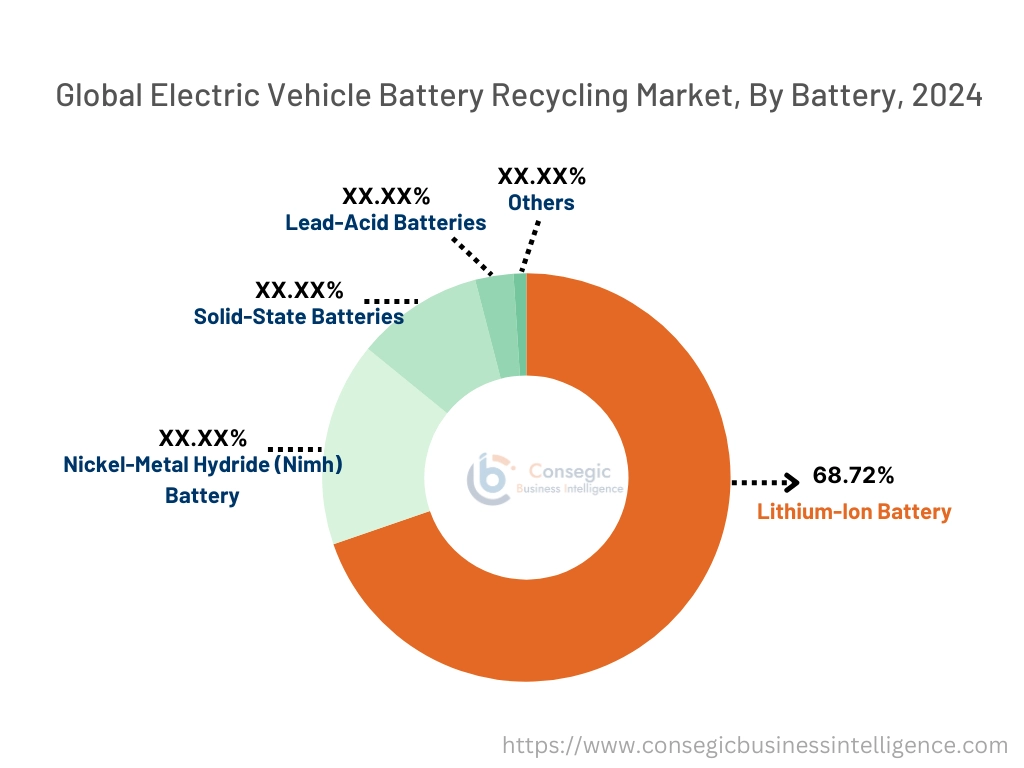
By Vehicle Type:
Based on the vehicle type, the market is segmented into passenger vehicles, commercial vehicles, and electric bikes.
Trends in the Vehicle Type:
- Rising adoption of electric passenger cars due to availability of wide range of models, eco-friendliness, and prevalence of several government incentives.
- Increasing utilization of electric bikes due to reduced carbon emissions and lower operational costs.
Passenger vehicles segment accounted for the largest in the total market share in 2024.
- Passenger vehicle refer to multi-track vehicle with at least two axles, intended for the carriage of passengers and designed to seat maximum nine individuals including the driver.
- Factors including the rising disposable income, growing popularity of luxury cars, and progressions in autonomous driving systems are among the primary factors driving the passenger cars segment.
- For instance, according to the International Organization of Motor Vehicle Manufacturers, the global sales of passenger car reached up to 65.27 million in 2023, representing an increase of 11.3% from 58.64 million in 2022
- According to the analysis, the rising adoption of passenger vehicles are driving the electric vehicle battery recycling market.
Electric bikes are anticipated to register a substantial CAGR growth during the forecast period.
- Electric bike refers to a motorized bicycle with an integrated battery for supplying power and electric motor for propulsion.
- Further, electric bikes have various advantages including reduced carbon emissions and low operational costs.
- For instance, according to International Energy Agency, the total sales of electric two-wheelers reached 5.9 million in China and 0.9 million in India in 2023.
- According to the analysis, the rising adoption of electric bikes are projected to drive the market during the forecast period.
Regional Analysis:
The regions covered are North America, Europe, Asia Pacific, the Middle East and Africa, and Latin America.
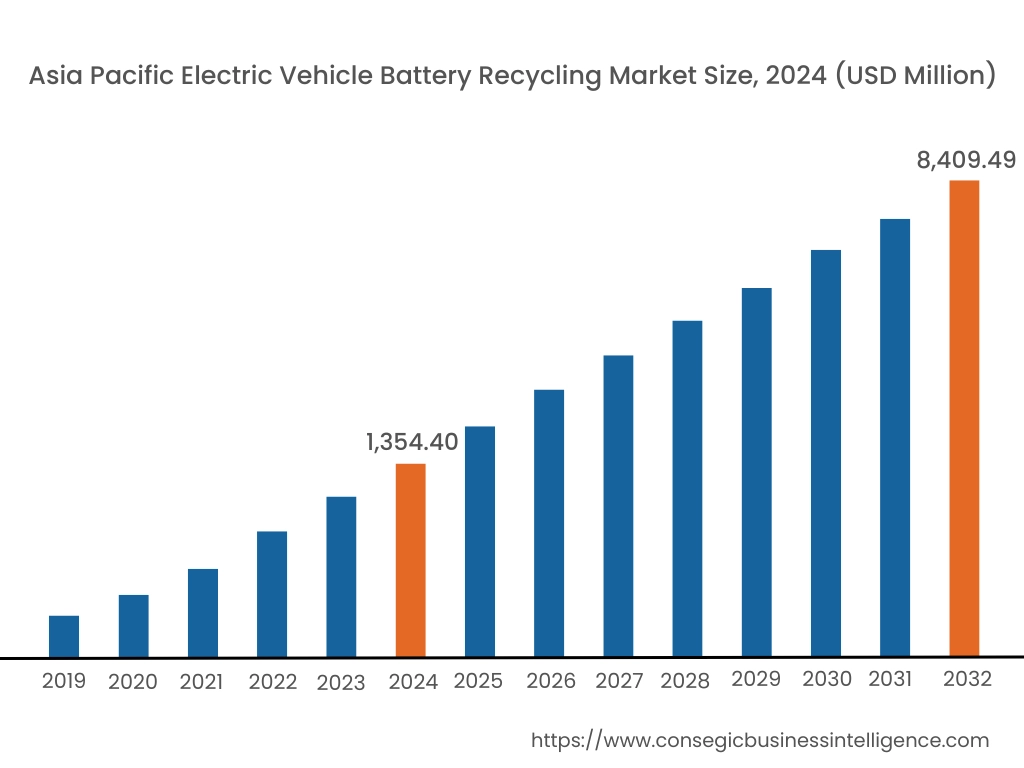
Asia Pacific region was valued at USD 1,354.40 Million in 2024. Moreover, it is projected to grow by USD 1,655.24 Million in 2025 and reach over USD 8,409.49 Million by 2032. Out of this, China accounted for the maximum revenue share of 36.8%. As per the electric vehicle battery recycling market analysis, there is an increasing adoption of EV battery recycling, particularly in countries such as China, India, and Japan, due to various government initiatives for supporting electric vehicle. The rapid development and growing investments in manufacturing plants for recycling electric vehicle batteries are accelerating the electric vehicle battery recycling market expansion.
- For instance, according to International Energy Agency, the total sales of battery electric vehicles (BEV) in China reached 16.1 million in 2023, depicting an increase from 10.7 million in 2022. Rising adoption of electric vehicles is driving the battery recycling market in the Asia pacific Region.
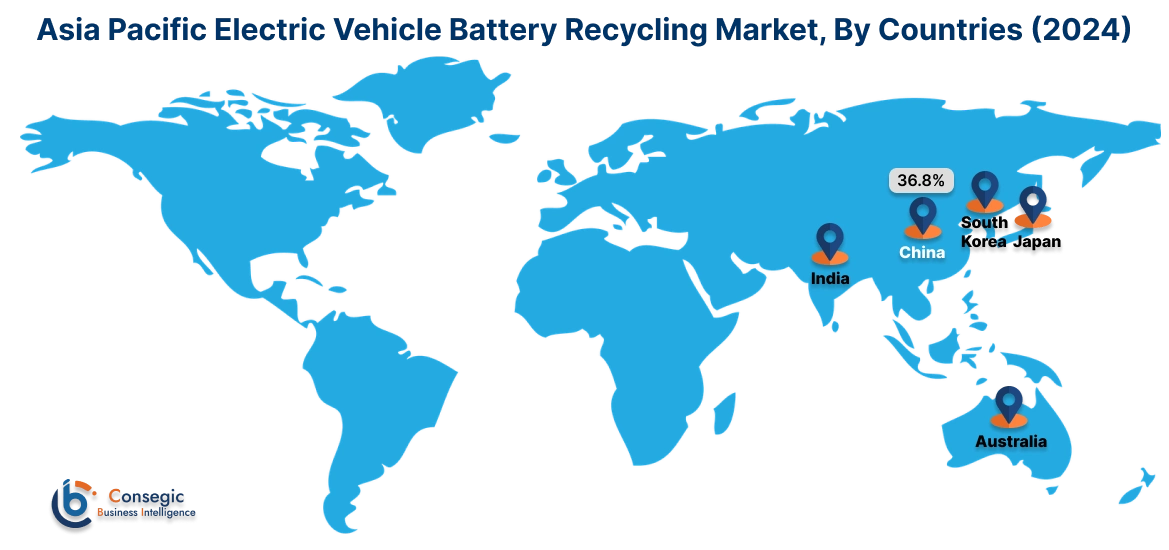
North America is estimated to reach over USD 5,333.84 Million by 2032 from a value of USD 891.35 Million in 2024 and is projected to grow by USD 1,085.97 Million in 2025.
In North America, the growth of electric vehicle battery recycling industry is driven by the rising demand of advanced sustainability solutions. Rising adoption of electric vehicles including passenger vehicles, commercial vehicles, and e-bikes are also driving the market growth. Further, increasing government inventive programs and supporting manufacturing policies for EVs and others are massively contributing growth in electric vehicle battery recycling market demand.
- For instance, in 2024, according to IEA (Internation Energy Agency), the total electric cars sold in United States accounted for 1.7 million units. The above factors are further expected to drive the market growth in North America during the forecast period.
The regional analysis depicts that the rising investments and stringent government regulations are increasing the adoption of recycled batteries, which in turn driving the electric vehicle battery recycling market demand in Europe. Further, as per the market analysis, the primary factor driving the market growth in the Middle East and African region includes increasing investment in sustainable electric vehicle solutions and growing EV industry. The rising demand for green energy and government incentives for EV industry are driving the market demand in the Latin America region.
Top Key Players and Market Share Insights:
The electric vehicle battery recycling market is highly competitive with major players providing services to the national and international markets. Key players are adopting several strategies in research and development (R&D), product innovation, and end-user launches to hold a strong position in the global electric vehicle battery recycling market. Key players in the electric vehicle battery recycling industry include -
- Contemporary Amperex Technology Co., Limited (China)
- Glencore (Switzerland)
- Ace Green Recycling, Inc. (USA)
- Highpower Technology Co., Ltd (China)
- Attero Recycling Pvt. Ltd (India)
- GEM Co., Ltd. (China)
- ERAMET (France)
- Li-Cycle Corp (Canada)
- Umicore (Belgium)
- Ecobat (US)
Recent Industry Developments :
Product Launch:
- In October 2024, Mercedes-Benz launched its first battery recycling plant in Europe, which features an advanced mechanical-hydrometallurgical process. The company aims to build the most desirable cars in a sustainable manner.
Partnership & Collaboration:
- In April 2024, European Union collaborated with India for promoting start-up collaboration on electric vehicles battery recycling under the India-EU Trade and Technology Council.
Electric Vehicle Battery Recycling Market Report Insights :
| Report Attributes | Report Details |
| Study Timeline | 2019-2032 |
| Market Size in 2032 | USD 21,343.89 Million |
| CAGR (2025-2032) | 28.1% |
| By Source |
|
| By Processes |
|
| By Battery |
|
| By Vehicle Type |
|
| By Region |
|
| Key Players |
|
| North America | U.S. Canada Mexico |
| Europe | U.K. Germany France Spain Italy Russia Benelux Rest of Europe |
| APAC | China South Korea Japan India Australia ASEAN Rest of Asia-Pacific |
| Middle East and Africa | GCC Turkey South Africa Rest of MEA |
| LATAM | Brazil Argentina Chile Rest of LATAM |
| Report Coverage |
|
Key Questions Answered in the Report
How big is the electric vehicle battery recycling market? +
The electric vehicle battery recycling market was valued at USD 3,512.48 Million in 2024 and is projected to grow to USD 21,343.89 Million by 2032.
Which is the fastest-growing region in the electric vehicle battery recycling market? +
Asia-Pacific is the region experiencing the most rapid growth in the electric vehicle battery recycling market.
What specific segmentation details are covered in the electric vehicle battery recycling report? +
The electric vehicle battery recycling report includes specific segmentation details for source, processes, battery, vehicle type, and region.
Who are the major players in the electric vehicle battery recycling market? +
The key participants in the electric vehicle battery recycling market are Contemporary Amperex Technology Co., Limited (China), Glencore (Switzerland), GEM Co., Ltd. (China), ERAMET (France), Li-Cycle Corp (Canada), Umicore (Belgium), Ecobat (US), Ace Green Recycling, Inc. (USA), Highpower Technology Co., Ltd (China), and Attero Recycling Pvt. Ltd (India).
